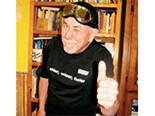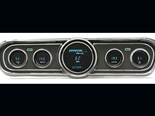Classic Car Instrument Panel Design - Blackbourn 407



|
Rob Blackbourn plays the numbers game
I loved the stunning range of lovely cars at last month’s Motorclassica event in Melbourne. As always the top-down roadsters and sports cars lured me into imagining myself behind the wheel, sampling the pleasure of the classic wind-in-your-hair driving experience. As I dreamed it struck me that while much of the basic architecture of these old-school cockpits survives in today’s cars, details have shifted in a big way. For example instrument-panel design has changed radically over the decades. Then, the ‘speedo’ was clearly the dominant instrument. Now, providing speed readings is but one of many functions of complex digital displays.
In those simpler times the speedo did way more than just display speed. As well as indicating your current rate of progress, it could answer the question asked by many a wide-eyed young car fan, if your car looked a bit tasty: "What’ll she do, mister?" Those were the days when anyone vaguely interested in performance would take their latest acquisition out on the highway and flatten it to see what it would ‘do’. And you would give it every chance, keeping the accelerator firmly nailed for five kays or more until the needle wouldn’t budge even one millimetre further up the scale. By comparison accurate acceleration times were difficult to pin down and any attempted improvement to your personal-best time between Melbourne and Sydney was at the mercy of the elements, and the number of caravans you encountered over the Razorback, and the punctures you suffered. But your car’s top speed was there on demand, right in front of you, on the speedo.
| Digital dashes for US classic cars

The speedo also provided what we could call an aspirational influence. Period speedometer-dial markings typically showed a full-scale speed that was beyond the car’s actual top-whack potential, by a margin of 20 miles-per-hour (mph) or more. The speedos of the majority of cars, including early ‘grey-motor’ Holdens, and even four-cylinder family cars, featured an especially alluring top number – 100mph (161km/h). The ‘magic ton’ was to many everyday rev-heads the ‘Holy Grail’ speed to aspire to, the more so because the tempting number was sitting there, on their own speedo dials.
With gravity giving you a helping hand, a good downhill run could typically get the needle seven or eight mph closer to the three-digit target than your car could manage on the flat. I can recall one mate’s early Holden lurching its way downhill in the orchard country north-east of Melbourne showing a pleasing 92 or 93mph. Later with twin Strombergs, a decent exhaust and a Wade cam it could pull those numbers on the flat – and it hit the jackpot downhill, while valve-bouncing loudly.

This speedo consciousness provided opportunity for a bit of fun when we went metric. During my time at Ford a primary-school mate of my young son was a real muscle-car fan who got pretty excited when I came home in anything decorated with ‘go fast’ stripes, or ‘Hi-Po’ badges. And he loved a spin round the block, and the sound of a fruity exhaust.
This junior rev-head came with us one Sunday for a bush barbecue in a new XB Fairmont 302 GS – it was the first I had driven featuring the recently introduced metric speedo. On the way home down the Maroondah Highway, I suggested he check out the speedo reading. The little guy grinned from ear to ear when he saw we were clocking 100. He couldn’t wait to tell his dad when I dropped him off. Once I had explained my little deception to his understandably concerned old man, the little bloke went off at me in a big way.
Unique Cars magazine Value Guides
Sell your car for free right here
Get your monthly fix of news, reviews and stories on the greatest cars and minds in the automotive world.
Subscribe

.jpg)













